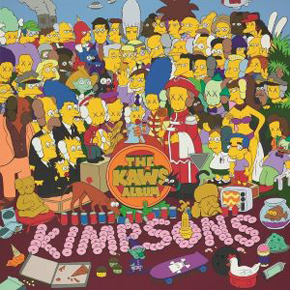1.1.25 — Smile!
What better way to welcome the new year than with my least favorite show of the past one? And it is not quite gone. Ring out the old as best you can.
Could KAWS be a serious collector? Your answer may depend on whether you accept him as a serious artist. I am not so sure, but the Drawing Center is counting on it, through January 19, with the KAWS collection.
 To be sure, his work is an assault on the whole idea of seriousness, in or out of art. His cast of characters, from the Simpsons to the Michelin Man, is always smiling. He can hardly restrain a smile himself with his second museum appearance in barely three years. Yet he is a collector, of thousands of pieces in an eclectic mix of art-world regulars and the comics. If you cannot tell the difference, that could be the point, and mainstream critics are eating it up. The KAWS collection searches for art high and low, in more than one sense, but its heart is in the comics and the comedy.
To be sure, his work is an assault on the whole idea of seriousness, in or out of art. His cast of characters, from the Simpsons to the Michelin Man, is always smiling. He can hardly restrain a smile himself with his second museum appearance in barely three years. Yet he is a collector, of thousands of pieces in an eclectic mix of art-world regulars and the comics. If you cannot tell the difference, that could be the point, and mainstream critics are eating it up. The KAWS collection searches for art high and low, in more than one sense, but its heart is in the comics and the comedy.
Right on the way in, to both sides of the entrance, KAWS includes colorful evil creatures out of an epic battle and reserved faces bearing the subtitle Original. But then you know not to look at either evil or claims for originality without smiling. Postmodernists questioning the “originality of the avant-garde” and post-Siri-alists can only agree. The collection includes self-taught artists like Adolf Wölfli along with street artists like FUTURA 2000, but then no one, however naïve, is immune to convention. What counts as outsider art anyway? Inquiring minds want to know.
KAWS himself (in real life, whatever that means, Brian Donnelly) began with graffiti and graduated to commerce. The highlight of his Brooklyn retrospective may well have been the gift shop, and the show was an exercise in branding for the museum as much as him. Even now, passing his huge cartoon Companions in the museum lobby, in polished wood, I cannot eradicate the pit in my stomach. The Drawing Center has only a modest lobby gift shop (with its own merchandise, not his), but it has succumbed to commercialism all the same. That still, though, leaves the real question: can it keep you smiling and get you thinking?
The results are mixed. KAWS could make Banksy, with his own museum just two blocks away, a model of self-sacrifice and Jeff Koons a model of integrity. And the layout can keep one guessing or get one giving up. The collection fills the entire Drawing Center in no obvious order, by theme or anything else. Three sections identify artists and titles only on plastic cards, and even those take an effort to find. Who needs artists anyway?
Taken differently, though, they create their own context for art. Two of the three resemble the living rooms and study centers favored by museums today. Works there hang on the wall and occupy platforms much like furniture, including robotic sculpture. And artists do cross over into the mainstream, including Joyce Pensato, Lee Lozano, and Willem de Kooning. Each has the fierceness of the artist’s own battles between forces of darkness and light. They leave open what to call demonic, sophisticated, or funny.
Too much else does not. R. Crumb has his usual high anxiety, and Peter Saul gets to misspell KILL, but you know their routine cold. Is there still something special about popular culture, alienation, or art? Just wait for the next installment in the series. KAWS is smart enough and dedicated enough to keep them coming. And for goodness sake keep smiling.
Read more, now in a feature-length article on this site.